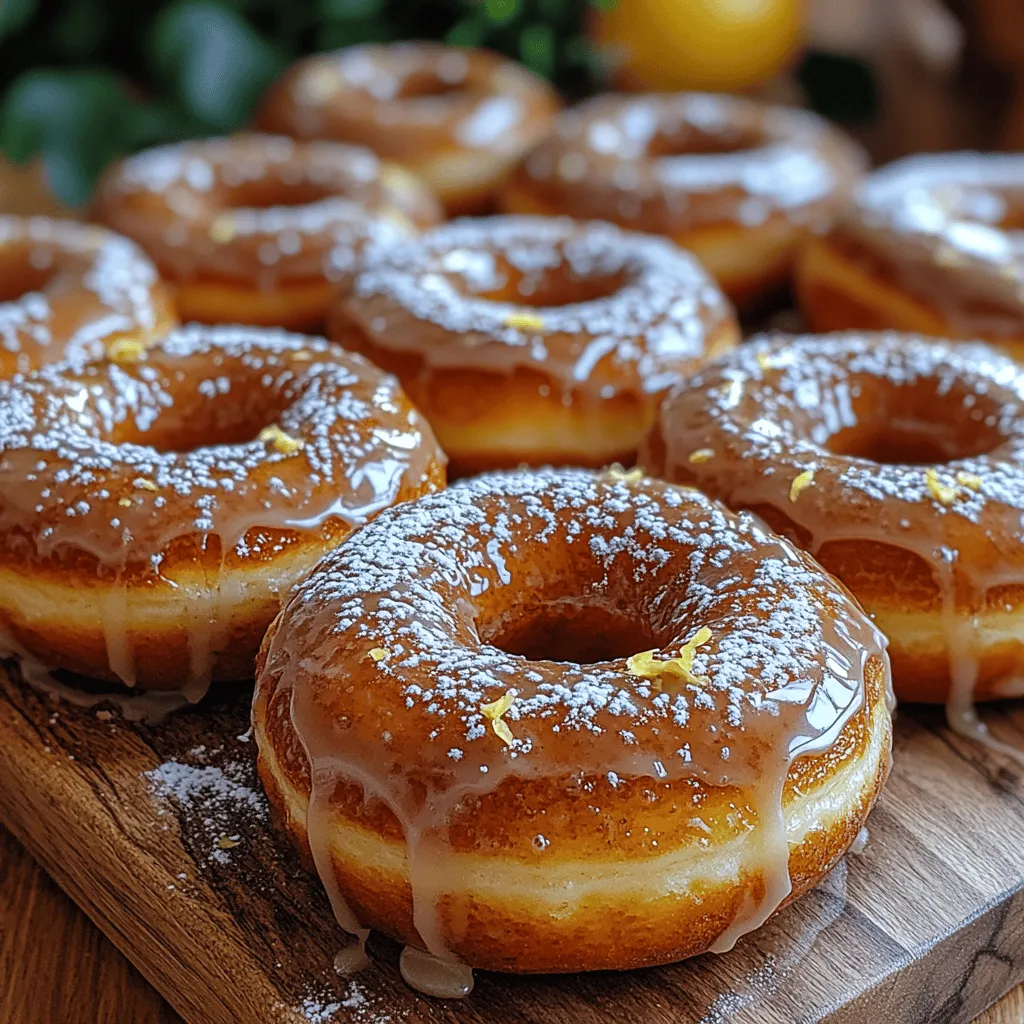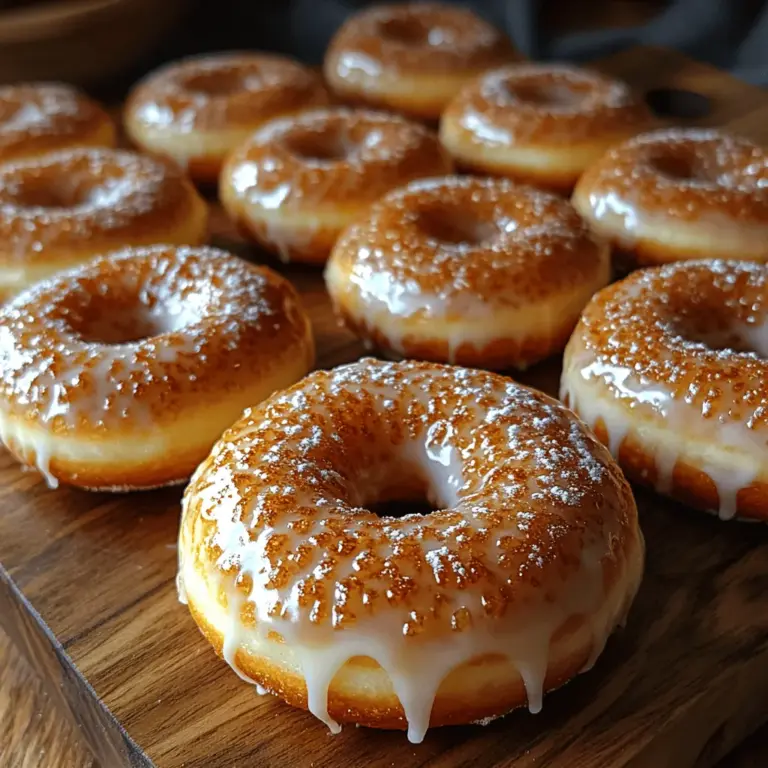Introduction
If you’re searching for a delightful and guilt-free indulgence, look no further than melt-in-mouth Greek yogurt donuts. These baked donuts are not only incredibly soft and fluffy but also packed with the goodness of Greek yogurt, making them a healthier alternative to traditional fried donuts. With a perfect balance of sweetness and a hint of tanginess, these treats are sure to impress both your family and friends. Whether you’re preparing for a casual weekend brunch, a birthday celebration, or simply craving a sweet snack, these donuts can be the star of the show.
This recipe combines simple ingredients that create a wonderfully moist texture while delivering a delicious flavor that’s hard to resist. The use of Greek yogurt not only enhances the flavor but also adds protein, ensuring that you can enjoy these donuts without the guilt. Let’s dive into the world of Greek yogurt donuts and explore why they are becoming a favorite in kitchens everywhere.
Understanding the Recipe
Description of the Dish
Melt-in-mouth Greek yogurt donuts are a baked version of the classic donut. Unlike their fried counterparts, these donuts are lighter, fluffier, and made with wholesome ingredients. They boast a soft texture that melts in your mouth, making them perfect for pairing with coffee or enjoying as a quick breakfast option. The addition of Greek yogurt gives them a unique twist, adding moisture and a subtle tang that balances the sweetness beautifully.
Origin and Cultural Significance
The origins of donuts can be traced back centuries, with various cultures having their own versions of fried or baked dough. However, the integration of Greek yogurt into desserts, particularly in modern healthy cooking, is a trend that has gained significant popularity in recent years. Greek yogurt is widely celebrated for its health benefits, including high protein content and probiotics. This recipe merges traditional donut-making with contemporary health trends, making it a delightful option for those who want to enjoy sweets without compromising their dietary goals.
Overview of Key Ingredients and Their Roles in the Recipe
The beauty of melt-in-mouth Greek yogurt donuts lies in their simplicity. The key ingredients include:
– Greek Yogurt: The star ingredient that provides moisture, tanginess, and protein. It helps to create a tender crumb in the donuts.
– All-Purpose Flour: The base of the donuts that gives them structure. You can experiment with whole wheat flour for a healthier twist.
– Baking Powder and Baking Soda: These leavening agents are crucial for achieving the light and fluffy texture of the donuts.
– Sugar: Adds sweetness to the batter. You can adjust the amount based on your preference or substitute with healthier options like honey or maple syrup.
– Eggs: Act as a binding agent, helping to hold the ingredients together while adding richness.
– Vanilla Extract: Enhances the flavor profile, giving the donuts a warm and inviting aroma.
– Nutmeg and Cinnamon: Optional spices that can be added for an aromatic touch, contributing to the overall flavor complexity.
Each of these ingredients serves a specific purpose, working harmoniously to create the perfect donut. Understanding their roles will help you appreciate the recipe and make informed adjustments as needed.
Ingredients Breakdown
Here’s a detailed list of the primary ingredients you will need to create melt-in-mouth Greek yogurt donuts:
– 1 cup (240g) Greek yogurt: Opt for plain, unsweetened Greek yogurt for the best results. This ingredient is crucial for achieving the desired moist texture and adds a subtle tangy flavor.
– 1 ½ cups (180g) all-purpose flour: This provides structure to the donuts. You can substitute half of this with whole wheat flour for added fiber.
– ½ cup (100g) sugar: Granulated sugar is typically used, but you can reduce the amount or switch to coconut sugar for a lower glycemic index alternative.
– 2 tsp baking powder: This helps the donuts rise, making them fluffy and light. Ensure your baking powder is fresh for the best results.
– ½ tsp baking soda: Works alongside the baking powder to create a perfect lift.
– 2 large eggs: They add moisture and help bind the ingredients together.
– 2 tsp vanilla extract: Provides depth and richness to the flavor.
– ½ tsp ground nutmeg (optional): Adds a hint of warm spice that complements the sweetness.
– ½ tsp ground cinnamon (optional): A classic spice in baking that enhances the flavor profile.
Suggestions for Ingredient Substitutions or Variations
– Gluten-Free Option: Replace all-purpose flour with a gluten-free blend that includes xanthan gum for structure.
– Dairy-Free Version: Use dairy-free yogurt and a egg substitute, such as flaxseed meal mixed with water or a commercial egg replacer.
– Sweetener Alternatives: Consider using honey, maple syrup, or agave nectar in place of granulated sugar. Adjust the liquid content of the recipe accordingly if using liquid sweeteners.
– Flavor Variations: Experiment with different extracts like almond or lemon, or add citrus zest to brighten up the flavor. You can also mix in chocolate chips or nuts for added texture and flavor.
Preparation Steps
Creating melt-in-mouth Greek yogurt donuts is a straightforward process that doesn’t require any special equipment. Here are the detailed steps to guide you through making these delightful treats:
Step 1: Preheat the Oven
Begin by preheating your oven to 350°F (175°C). Preheating is essential for achieving the right texture, as it ensures that the donuts will rise properly as soon as they hit the hot oven.
Step 2: Prepare the Donut Pan
While the oven is preheating, prepare your donut pan by lightly greasing it with non-stick cooking spray or brushing it with melted butter. This will help the donuts release easily once they are baked.
Step 3: Combine Dry Ingredients
In a large mixing bowl, whisk together the all-purpose flour, sugar, baking powder, baking soda, and any optional spices (nutmeg and cinnamon). Mixing the dry ingredients first ensures that the leavening agents are evenly distributed throughout the flour, which is crucial for consistent rising.
Step 4: Mix Wet Ingredients
In a separate bowl, combine the Greek yogurt, eggs, and vanilla extract. Whisk them together until smooth and well combined. The yogurt should be at room temperature for easier mixing, so consider taking it out of the refrigerator ahead of time.
Step 5: Combine Wet and Dry Mixtures
Create a well in the center of the dry ingredient mixture and pour in the wet ingredients. Gently fold the mixture with a spatula until just combined. Be careful not to overmix, as this can lead to dense donuts. The batter should be thick but smooth.
Step 6: Fill the Donut Pan
Using a piping bag or a spoon, fill each cavity of the donut pan about halfway full with the batter. This allows enough space for the donuts to rise without overflowing.
Step 7: Bake
Place the filled donut pan in the preheated oven and bake for 10-12 minutes or until the edges are lightly golden and a toothpick inserted into the center comes out clean. Keep an eye on them, as baking times may vary depending on your oven.
Step 8: Cool and Remove
Once baked, remove the donut pan from the oven and allow it to cool for a few minutes before transferring the donuts to a wire rack. This will help the donuts set properly and maintain their shape.
Tips for Efficient Preparation and Mise en Place
– Mise en Place: Organize all your ingredients before you start cooking. Measure out the quantities and have them ready to go. This will streamline the process and prevent any mishaps.
– Cooking Tools: Ensure you have all necessary tools at hand, including mixing bowls, measuring cups, a whisk, and a piping bag or spoon for filling the donut pan.
– Baking in Batches: If you don’t have a donut pan, consider using a muffin tin. Simply adjust the baking time accordingly, as muffins may take a few extra minutes to bake.
Importance of Each Step in Achieving the Desired Outcome
Each step in the preparation process is crucial for ensuring that your donuts turn out perfectly. From preheating the oven to combining the dry and wet ingredients with care, every detail contributes to the overall texture and flavor of the finished product. Skipping steps or rushing through them can lead to undesirable results, such as dense donuts or uneven baking.
Cooking Techniques
Baking is the primary cooking method used in this recipe, which differs from traditional frying methods often associated with donuts. Here’s a closer look at the techniques involved and why they matter:
Overview of Cooking Methods Used in the Recipe
Baking allows for a lighter texture and a healthier profile as it significantly reduces the amount of oil needed. The heat from the oven surrounds the donuts, cooking them evenly and helping them rise without the need for frying.
Explanation of Any Special Techniques or Equipment Required
– Donut Pan: While you can use a muffin tin as an alternative, a donut pan is specially designed to create that classic donut shape. It also aids in even cooking due to its shallow cavities.
– Piping Bag: Using a piping bag to fill the donut pan can help you achieve a more uniform shape and size, ensuring even baking.
Insights on Temperature Control and Timing
Maintaining the right oven temperature is key for successful baking. An oven that is too hot can cause the donuts to bake too quickly, leading to a dense interior. Conversely, an oven that is not hot enough will result in donuts that do not rise properly. It’s also important to keep an eye on baking times, as each oven can vary slightly in performance.
Flavor Profile and Pairings
The flavor profile of melt-in-mouth Greek yogurt donuts is beautifully balanced. With the natural sweetness from the sugar and the slight tang from the Greek yogurt, each bite is a harmonious blend of flavors. The optional spices add warmth and depth, making these donuts a delightful treat any time of the day.
These donuts pair wonderfully with a variety of beverages. Consider serving them with a cup of freshly brewed coffee, a glass of cold milk, or even a fruit smoothie for a wholesome breakfast or snack. Drizzling them with a light glaze or dusting them with powdered sugar can elevate the experience, adding a touch of sweetness without overwhelming the palate.
—
As you can see, melt-in-mouth Greek yogurt donuts are an exceptional treat that combines health and indulgence. The next section will delve into the finishing touches and additional tips to ensure your donuts are a hit!

Suggested Side Dishes or Accompaniments
When it comes to serving your melt-in-mouth Greek yogurt donuts, consider pairing them with delightful side dishes or accompaniments that complement their rich, sweet flavor. Here are some suggestions to elevate your dessert experience:
1. Fresh Fruit Salad: A vibrant mix of seasonal fruits such as berries, melons, and citrus can provide a refreshing contrast to the sweetness of the donuts. The acidity from the fruits balances the dense texture, making for a well-rounded meal.
2. Greek Yogurt Parfait: Layering Greek yogurt with granola and fresh fruits creates a delicious parfait that can be served alongside the donuts. This adds a creamy texture and nutritional value while enhancing the Greek yogurt theme.
3. Nut Butter Dips: Serve your donuts with a side of almond or peanut butter for a protein-packed dip. The nutty flavor pairs beautifully with the subtle sweetness of the donuts and adds a satisfying crunch.
4. Chocolate Ganache or Glaze: For those who want an extra indulgent treat, offering a side of rich chocolate ganache or glaze can turn your donuts into a decadent dessert. This addition will appeal to all chocolate lovers.
5. Cream Cheese Frosting: A light spread of cream cheese frosting can add a tangy sweetness that complements the donuts without overpowering them.
Beverage Pairings to Enhance the Dining Experience
The right beverage can significantly enhance the enjoyment of your Greek yogurt donuts. Here are some pairing suggestions that will elevate your dining experience:
1. Coffee: A classic pairing, the rich flavors of coffee—be it espresso, cappuccino, or a simple brewed cup—can beautifully complement the sweetness of the donuts. The slight bitterness from the coffee balances the sugar, making each bite more enjoyable.
2. Tea: Herbal teas, such as chamomile or mint, can provide a soothing contrast to the sweetness. Alternatively, a spiced chai can add warmth and additional flavor complexity to the meal.
3. Milk or Plant-Based Milk Alternatives: A cold glass of milk—dairy or plant-based—makes a classic accompaniment for donuts. The creamy texture of milk balances the flavors nicely and can be enjoyed either cold or warm.
4. Fruit Juices: Freshly squeezed orange juice or a berry-infused lemonade can add a refreshing zest that cuts through the sweetness of the donuts, creating a well-rounded breakfast or dessert experience.
Nutritional Information
Understanding the nutritional content of your Greek yogurt donuts can help you enjoy them mindfully. Here’s a breakdown of the key nutritional components per serving (one donut):
– Calories: Approximately 150-200 calories
– Protein: 3-4 grams
– Fat: 5-7 grams
– Carbohydrates: 20-25 grams
– Fiber: 1-2 grams
– Sugar: 10-15 grams
Health Benefits of Key Ingredients
1. Greek Yogurt: Rich in protein and probiotics, Greek yogurt supports digestion and helps maintain healthy gut flora. Additionally, it provides calcium, which is essential for bone health.
2. Whole Wheat Flour: Using whole wheat flour instead of all-purpose flour adds fiber and nutrients, contributing to better digestion and sustained energy levels.
3. Natural Sweeteners: If you opt for honey or maple syrup as natural sweeteners, you benefit from their antioxidant properties compared to refined sugars.
Dietary Restrictions and Accommodations
To make this recipe more inclusive, consider the following adaptations for dietary restrictions:
– Gluten-Free Option: Substitute whole wheat flour with gluten-free all-purpose flour or almond flour for those with gluten sensitivities.
– Dairy-Free Version: Use coconut yogurt or almond yogurt in place of Greek yogurt for a dairy-free alternative.
– Reduced Sugar: You can decrease the amount of sweetener or use a sugar substitute for a lower-calorie version.
Serving Suggestions
Presentation plays a key role in making your melt-in-mouth Greek yogurt donuts enticing. Here are some tips for serving:
1. Plating: Arrange donuts on a decorative platter or tiered stand for a visually appealing display. Dust with powdered sugar or drizzle with glaze to enhance their look.
2. Garnishing: Fresh herbs, such as mint or basil, can add a pop of color and freshness to your presentation. Alternatively, a sprinkle of crushed nuts can provide texture and an appealing visual contrast.
3. Portion Control: Cut larger donuts into halves or quarters for smaller portions, making them perfect for sharing. This also allows guests to try different flavors or varieties without feeling overwhelmed.
Storage and Reheating
Proper storage and reheating methods are essential for maintaining the freshness of your donuts:
1. Storing Leftovers: Keep any leftover donuts in an airtight container at room temperature for up to two days. If you want them to last longer, refrigerate them, but be aware that refrigeration may affect the texture.
2. Reheating Tips: To enjoy your donuts warm, preheat your oven to 350°F (175°C) and place them on a baking sheet for about 5-10 minutes. This will help restore their softness without making them soggy.
3. Freezer-Friendly Options: If you’d like to store donuts for a longer period, consider freezing them. Wrap each donut tightly in plastic wrap and place them in a freezer-safe bag. They can be frozen for up to three months. When ready to enjoy, thaw overnight in the refrigerator, then reheat in the oven.
Common Mistakes to Avoid
While making Greek yogurt donuts is straightforward, there are a few common pitfalls to watch out for:
1. Overmixing the Batter: Mixing the batter too much can lead to dense donuts. Stir until just combined to keep them light and fluffy.
2. Incorrect Oven Temperature: Always preheat your oven to the specified temperature. If the oven is too hot or too cool, it can affect the cooking time and texture of the donuts.
3. Skipping the Cooling Process: Allow your donuts to cool in the pan for a few minutes before transferring them to a wire rack. This prevents them from sticking and ensures even cooling.
4. Not Measuring Ingredients Accurately: Baking is a science, so precise measurements are critical. Use a kitchen scale for the best results, especially with ingredients like flour and sugar.
5. Ignoring Taste Tests: Always taste your batter before baking to adjust sweetness or flavoring. This is particularly important if you’re making substitutions.
Conclusion
Melt-in-mouth Greek yogurt donuts are not just a delightful treat; they represent versatility in the kitchen, allowing for a range of flavors and presentations. Their appealing texture and rich taste make them suitable for breakfast, snacks, or dessert. By exploring various side dishes and beverage pairings, you can create a memorable dining experience that satisfies all palates.
Don’t hesitate to experiment with flavors and garnishes, making these donuts your own. Whether you’re sharing them with friends or enjoying them on a quiet morning, the joy of cooking and sharing meals is truly one of life’s greatest pleasures. Embrace the art of cooking, and let these Greek yogurt donuts inspire you to create more delicious moments in your kitchen.

